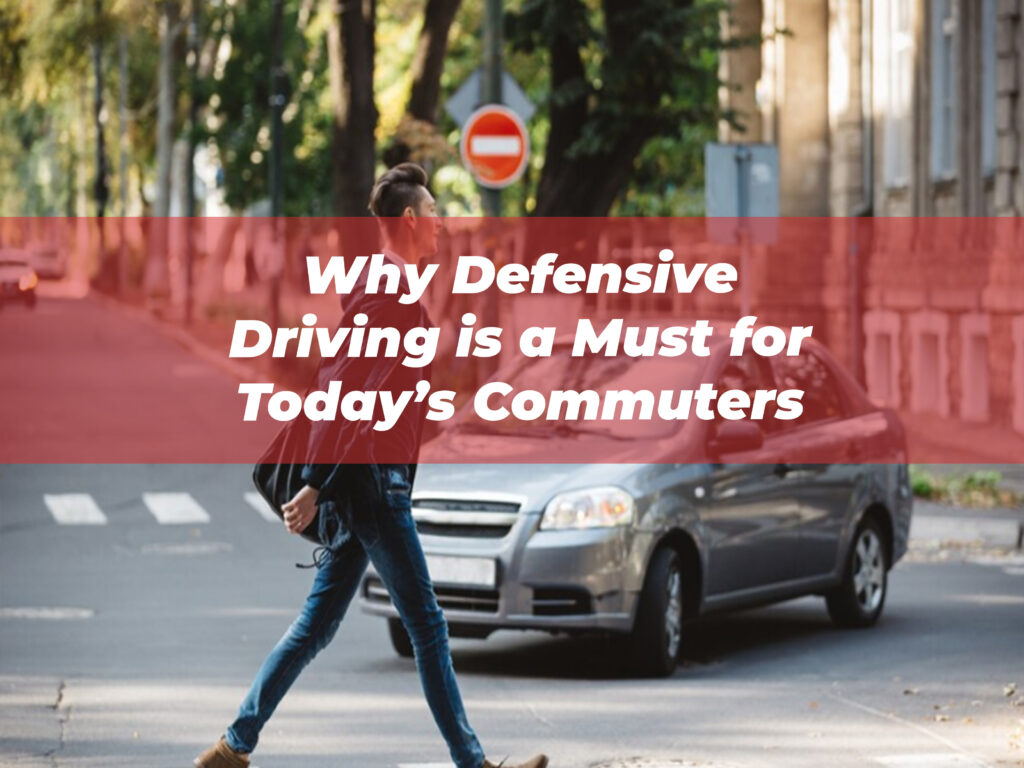Commuting has become a daily routine for millions of people. Whether it’s the hustle of a morning rush hour or a quiet drive to run errands, being on the road comes with its share of challenges. Traffic congestion, distracted drivers, road rage, and unexpected hazards are just a few of the risks faced by commuters. The need for safety has never been greater, and this is where driving steps in as a game-changer.
Defensive driving isn’t just about obeying traffic laws. It’s a proactive approach to driving that helps you anticipate hazards, avoid accidents, and ensure the safety of everyone on the road. This blog breaks down why is a critical skill for today’s commuters and how you can incorporate its principles into your daily routine.
What Is Defensive Driving?
Skills and techniques that go beyond basic Defensive Driving knowledge. It focuses on predicting and avoiding potential hazards, improving reaction times, and making safe decisions. The goal of driving is to minimize risks, even when other drivers or external conditions are unpredictable.
At its core, promotes constant vigilance, excellent situational awareness, and patience. It’s about staying in control of your vehicle and your emotions while navigating challenging road scenarios.
The Growing Need for Defensive Driving
The modern commuter faces road conditions that are far more complex than in the past. Here are some key factors driving the need for defensive driving techniques today:
1. Increased Traffic and Congestion
With urban areas growing rapidly, roads are busier than ever. More Defensive Driving on the road often lead to more accidents, delays, and tense driving conditions. Defensive driving can help you safely maneuver through high-traffic situations by improving your ability to stay calm and alert.
2. Aggressive and Distracted Drivers
From speeding to tailgating, aggressive behaviors are becoming alarmingly common. Add to this the prevalence of distractions like texting or talking on the phone, and you have a recipe for disaster. Defensive driving teaches you how to protect yourself from these risks.
3. Unpredictable Weather Conditions
Rain, fog, snow, and ice can make commuting hazardous. Defensive Driving equips you with strategies to safely adjust your driving based on the conditions.
4. Rising Accident Rates
Reports consistently show that car accidents remain a leading cause of injury and death worldwide. Many of these accidents are preventable with defensive driving practices.
Principles of Defensive Driving
To become a defensive driver, you must adopt certain principles that prioritize safety and foresight. Here are the key elements of defensive driving:
1. Stay Focused At All Times
Defensive driving starts with full attention to the road. Avoid distractions, such as mobile phones, eating, or adjusting the navigation system while driving.
2. Keep a Safe Following Distance
Maintain a minimum of a three-second gap between your car and the vehicle in front of you. This gives you ample time to react to sudden stops.
3. Anticipate Others’ Behavior
Always be prepared for the unexpected. Assume that other Defensive Driving may not always follow traffic rules and stay alert for signs of risky behavior.
4. Control Your Speed
Driving at a safe speed helps you maintain control of your vehicle and allows you more time to react to potential dangers.
5. Leave an Escape Route
Always position your vehicle in a way that lets you quickly move to safety if needed. Avoid being boxed in by other Defensive Driving, especially in high-traffic areas.
6. Adjust for Road Conditions
Be adaptable. Poor weather, construction zones, or uneven road surfaces require additional caution and lower speeds.

7. Use Your Mirrors and Blind Spots
Check your mirrors frequently and always look over your shoulder when changing lanes. Blind spots can easily lead to accidents if ignored.
Make Early Decisions
Whether you’re merging onto a highway or approaching an intersection, make your decisions well in advance. Last-minute actions can result in confusion or accidents.
Benefits of Defensive Driving
Defensive Driving doesn’t just keep you safe; it offers a range of benefits for your overall driving experience.
1. Reduced Risk of Accidents
By being more aware of your surroundings and proactively avoiding hazards, you significantly lower your risk of getting into an accident.
2. Lower Insurance Costs
Some insurance providers offer discounts for drivers who complete defensive driving courses. Fewer accidents and traffic violations also contribute to lower premiums.
3. Decreased Stress Levels
Adopting a calm and defensive approach helps reduce the anxiety and frustration that often come with commuting. The right mindset makes for a more enjoyable drive.
4. Better Fuel Efficiency
Smooth, defensive driving often results in better gas mileage. Avoiding harsh braking, rapid Defensive Driving, and unnecessary speed changes saves fuel.
5. Lifelong Driving Skills
Defensive driving isn’t a one-time skill. The techniques you learn can be applied for years, helping you remain a safe and conscientious driver.
Road Risks Commuters Face Daily
Even the best drivers can encounter hazards on the road. Defensive driving is especially important for managing some of the most common risks faced by commuters:
1. Distracted Drivers
From texting to multitasking, distracted driving is one of the leading causes of accidents today. Defensive drivers are trained to spot and avoid these high-risk individuals.
2. Sudden Stops
Tailgating often leads to rear-end collisions when the car in front stops unexpectedly. Keeping a safe distance minimizes this risk.
3. Merging and Lane Changes
Drivers who fail to signal or check their blind spots before changing lanes can cause accidents. Defensive drivers anticipate these movements and stay prepared.
4. Pedestrian and Cyclist Hazards
Busy urban areas often see unpredictable movements from pedestrians and cyclists. Defensive driving focuses on staying alert around crosswalks and bike lanes.
5. Weather-Related Challenges
Sudden rain showers, icy roads, or dense fog can create treacherous conditions. Prioritizes slow speeds, increased following distance, and smooth movements.
6. Impaired Drivers
Although driving under the influence is illegal, there’s always a risk of sharing the road with impaired drivers. Techniques like maintaining a safe distance and staying vigilant can protect you in these scenarios.
Actionable Tips to Adopt Defensive Driving Habits
Every commuter should strive to incorporate driving habits into their daily routine. Here are some actionable tips to get you started:
1. Take a Defensive Driving Course
A certified course offers expert instruction on safe driving techniques, tailored to real-life road scenarios.
2. Perform Regular Vehicle Maintenance
Keeping your car in top condition reduces the chances of mechanical failures that can lead to accidents. Regularly check your brakes, tires, Defensive Driving, and fluids.
3. Prepare Mentally Before Driving
Stay calm and focused when you get behind the wheel. Avoid Defensive Driving if you’re fatigued, upset.
4. Limit Distractions
Use hands-free devices for Defensive Driving, set your GPS before starting your trip, and keep your hands on the wheel and eyes on the road.
5. Practice Slow and Steady Driving
Avoid aggressive behaviors like speeding, tailgating, or weaving through traffic. Patience goes a long way in keeping roads safer.
6. Use Defensive Techniques in Specific Scenarios
- Highway Driving: Maintain a consistent speed and use your mirrors Defensive Driving.
- Intersections: Make eye contact with other drivers or pedestrians to confirm who has the right of way.
- Night Driving: Use your headlights appropriately and remain cautious of impaired or drowsy drivers.
7. Stay Educated
Road conditions, laws, and best practices evolve over. Stay informed about changes and keep refreshing your knowledge.
Why Defensive Driving Courses Are Worth It
One of the best ways to master is by enrolling in a professional course. Defensive driving courses are designed to teach you advanced skills, improve your confidence behind the wheel, and prepare you for emergencies.
What You’ll Learn in a Defensive Driving Course
- Advanced braking and handling techniques
- How to identify and respond to road hazards
- Managing distractions and stress while
- The effects of impaired or aggressive driving and how to handle such drivers
These courses are often affordable and can save you money on insurance premiums. They’re also great for new Defensive Driving looking to build confidence and experienced drivers seeking to refine their skills.
Wrapping It Up
Defensive Driving is no longer an optional skill for today’s commuters; it’s a must. With roads becoming more crowded and unpredictable, being proactive and cautious can mean the difference between a safe commute and a preventable accident.
By understanding the principles of, recognizing the risks, and adopting best practices, you’re not only protecting yourself but also contributing to safer roads for everyone.
Take control of your safety today by practicing habits. Consider enrolling in a defensive driving course to take your skills to the next level. Share the importance of with your loved ones and encourage them to prioritize safety on the road.
Safe driving isn’t just good practice—it’s a responsibility we all share. Let’s commit to making our commutes safer and stress-free, one drive at a time!










